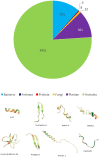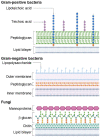Alternative Antibiotics in Dentistry: Antimicrobial Peptides
- PMID: 36015305
- PMCID: PMC9412702
- DOI: 10.3390/pharmaceutics14081679
Alternative Antibiotics in Dentistry: Antimicrobial Peptides
Abstract
The rise of antibiotic resistant bacteria due to overuse and misuse of antibiotics in medicine and dentistry is a growing concern. New approaches are needed to combat antibiotic resistant (AR) bacterial infections. There are a number of methods available and in development to address AR infections. Dentists conventionally use chemicals such as chlorohexidine and calcium hydroxide to kill oral bacteria, with many groups recently developing more biocompatible antimicrobial peptides (AMPs) for use in the oral cavity. AMPs are promising candidates in the treatment of (oral) infections. Also known as host defense peptides, AMPs have been isolated from animals across all kingdoms of life and play an integral role in the innate immunity of both prokaryotic and eukaryotic organisms by responding to pathogens. Despite progress over the last four decades, there are only a few AMPs approved for clinical use. This review summarizes an Introduction to Oral Microbiome and Oral Infections, Traditional Antibiotics and Alternatives & Antimicrobial Peptides. There is a focus on cationic AMP characteristics and mechanisms of actions, and an overview of animal-derived natural and synthetic AMPs, as well as observed microbial resistance.
Keywords: AMPs; anti-microbial peptides; antibiotic resistance; microbiome; oral infections.
Conflict of interest statement
The authors declare no conflict of interest.
Figures






References
-
- Burcham Z.M., Garneau N.L., Comstock S.S., Tucker R.M., Knight R., Metcalf J.L., Miranda A., Reinhart B., Meyers D., Woltkamp D., et al. Patterns of Oral Microbiota Diversity in Adults and Children: A Crowdsourced Population Study. Sci. Rep. 2020;10:2133. doi: 10.1038/s41598-020-59016-0. - DOI - PMC - PubMed
-
- Dominguez-Bello M.G., Costello E.K., Contreras M., Magris M., Hidalgo G., Fierer N., Knight R. Delivery mode shapes the acquisition and structure of the initial microbiota across multiple body habitats in newborns. Proc. Natl. Acad. Sci. USA. 2010;107:11971–11975. doi: 10.1073/pnas.1002601107. - DOI - PMC - PubMed
Publication types
Grants and funding
LinkOut - more resources
Full Text Sources
Research Materials

